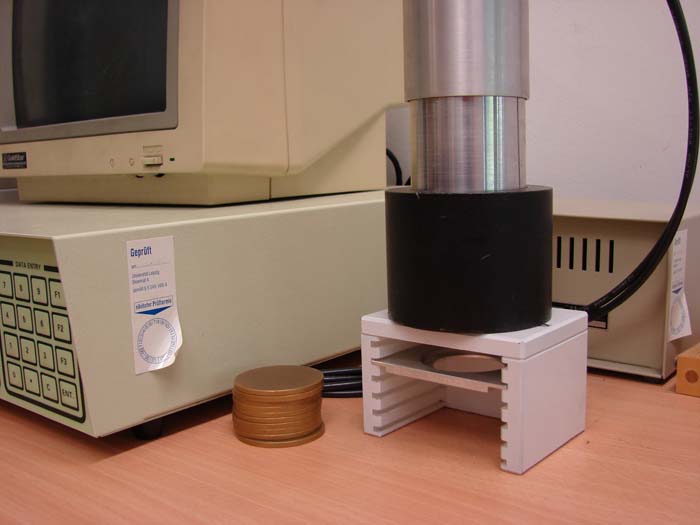ASTM C1347 Gamma Spectrometry of Mixed Oxide (MOX) Fuels
The ASTM C1347 standard outlines a method for determining the isotopic composition and elemental concentrations in mixed oxide (MOX) fuels using gamma spectroscopy. MOX fuel is a key component in advanced nuclear reactors, combining uranium and plutonium oxides to enhance efficiency and safety. This service is critical for ensuring compliance with international standards and regulations related to nuclear materials.
Gamma spectrometry involves the use of specialized detectors capable of detecting and quantifying gamma radiation from specific isotopes present in MOX fuel. The process begins with the preparation of a sample, which must be ground finely to ensure uniformity and minimize surface effects. Once prepared, the sample is placed into a suitable holder for analysis.
The testing procedure involves irradiating the sample with high-energy X-rays or gamma rays, then measuring the emitted gamma radiation using a spectrometer. This allows for precise determination of isotopic ratios such as 235U/239Pu and other relevant elements like fission products. The data collected is used to calculate elemental concentrations based on known calibration curves.
ASTM C1347 specifies the use of high-purity germanium (HPGe) detectors for accurate measurement, although silicon drift detectors may also be employed depending on specific requirements. Calibration using certified reference materials ensures reliable results that are traceable to international standards.
The isotopic ratios derived from this analysis play a crucial role in verifying the declared composition of MOX fuel batches against specified limits set by regulatory bodies like the International Atomic Energy Agency (IAEA). This helps maintain transparency and trust within the nuclear industry while ensuring safety and efficiency in reactor operations.
By adhering strictly to ASTM C1347, laboratories can provide robust evidence supporting compliance with relevant international standards such as IAEA guidelines. Such adherence not only enhances credibility but also facilitates smoother interactions between manufacturers, regulators, and users of MOX fuel worldwide.
In summary, ASTM C1347 gamma spectrometry serves an essential function in the quality control and assurance processes associated with MOX fuels. Through precise measurement techniques and rigorous calibration procedures, this service ensures accurate determination of isotopic compositions and elemental concentrations, thereby contributing significantly to nuclear safety and regulatory compliance.
For those involved in the development or procurement of MOX fuel, understanding these testing methods is vital for maintaining high standards throughout production cycles. By leveraging this expertise, organizations can enhance their reputation as reliable suppliers of compliant materials, fostering long-term partnerships based on mutual trust and shared objectives.
Quality and Reliability Assurance
The process described in ASTM C1347 is designed to deliver highly accurate and repeatable results through stringent quality control measures. Ensuring reliability involves several key steps:
- Sample Preparation: Each sample undergoes careful grinding using appropriate sieves to achieve uniform particle size distribution.
- Calibration: Certified reference materials are used to calibrate the spectrometer before each analysis, ensuring consistent readings across multiple tests.
- Data Analysis: Advanced software packages process raw data to generate detailed reports on isotopic ratios and elemental concentrations.
Regular audits by independent third parties verify compliance with both procedural guidelines and output specifications. These continuous quality checks help maintain the integrity of results throughout the lifecycle of a MOX fuel batch.
Moreover, adherence to international standards such as ASTM C1347 ensures that all testing practices align closely with industry best practices. This alignment promotes confidence among stakeholders regarding the accuracy and precision of reported findings.
Environmental and Sustainability Contributions
The accurate determination of isotopic compositions in MOX fuels through gamma spectrometry supports environmental sustainability initiatives by facilitating safer nuclear waste disposal processes. Understanding exactly what materials are contained within a given fuel batch allows for more effective management strategies aimed at minimizing risks associated with radioactive contamination.
For instance, knowing the precise levels of fissile material (like 235U) enables targeted treatment approaches that reduce overall volumes while retaining essential attributes necessary for safe handling and storage. This knowledge also aids in designing reactors configured to utilize lower enriched fuels more efficiently, thereby reducing reliance on highly processed uranium resources.
Additionally, the ability to monitor changes over time can help identify trends indicative of potential issues early enough to implement corrective actions before they escalate into larger problems requiring extensive remediation efforts. Such proactive measures contribute positively towards achieving long-term sustainability goals within the nuclear sector.
Competitive Advantage and Market Impact
Organizations capable of offering ASTM C1347 gamma spectrometry services stand to gain significant competitive advantages in both domestic and international markets. The ability to provide accurate, reliable data on MOX fuel compositions enhances trustworthiness among clients and partners.
- Regulatory Compliance: Meeting stringent regulatory requirements sets a benchmark for excellence that competitors strive to match or surpass.
- Enhanced Reputation: Consistently delivering high-quality results builds a reputation as a trusted partner in the nuclear industry, attracting more business opportunities.
- Innovation Support: Accurate testing data enables manufacturers to innovate safer and more efficient fuel designs without compromising safety standards.
Beyond mere compliance, laboratories offering these services can drive innovation by providing insights that inform new approaches to reactor design, waste management, and other aspects of nuclear engineering. This forward-thinking perspective positions organizations at the forefront of technological advancements within their respective fields.
The demand for accurate analysis methods like those specified in ASTM C1347 continues to grow as industries seek ways to improve efficiency while adhering strictly to environmental protection measures. By staying ahead of this trend, companies can secure a strong foothold in growing markets driven by increasing awareness about responsible resource utilization and nuclear safety.





